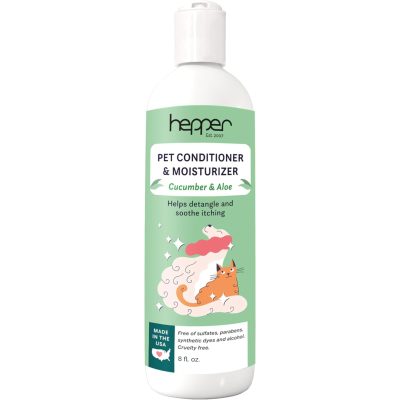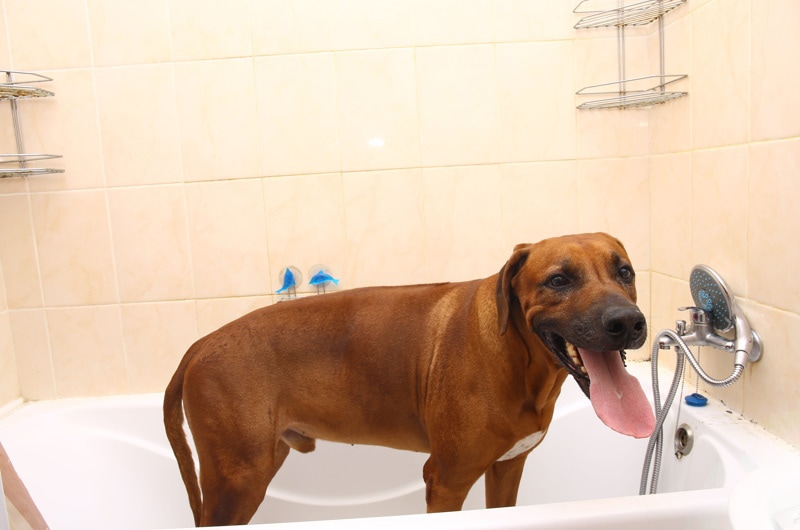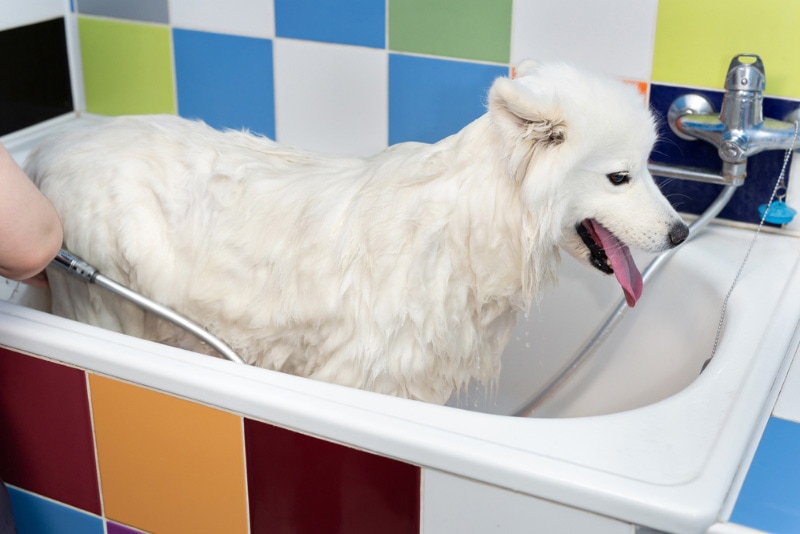In this article
View 2 More +Bathing your dog is one of those non-negotiable grooming chores all dog owners need to face occasionally. Luckily, some dogs don’t need to be bathed super often, but it is still a task many owners dread. This is especially true if you have a large breed of dog. Most toy or small dogs can easily fit into bathtubs and sinks, but if you are trying to bathe your St. Bernard in your apartment-sized tub, it will be a challenge.
If you are dreading bathing your big dog, we can help. Read on to find top tips to make the process easier for both you and your pup.

Important Things to Know Before You Start
The earlier you start giving baths, the better.
If your dog is still a puppy, you can train them not only to tolerate but actually enjoy their baths. However, that’s not to say an older dog can’t learn to like their baths. It’s just easier for puppies to make positive associations with experiences if they don’t have much experience to go on, and they are generally accepting of new experiences until around 14 weeks of age. An older dog has likely already been bathed plenty of times and has forged their own associations with the process. Or maybe they haven’t, and now as a result they are fearful of the unknown.
Use the right size bathing area.
The problem with bathing large and extra-large dog breeds at home is that they often require a bigger space than we have available to us. Some bigger dogs can bathe comfortably in your bathtub, while others will find the space far too constricting. A walk-in shower or wet room may be necessary for some particularly large dogs, but we realize it’s not really realistic to ask you to do a home renovation if you don’t already have these at your disposal.
We mention it because it’s worth considering if you don’t have the space to bathe your big pooch at home, you may need to commit to doing it elsewhere. For example, if it’s warm outside, you can bathe them in your yard. If it’s cool, you can try using a kiddie pool set up in a large space in your home if you don’t mind getting wet.

Use treats to your advantage.
Use treats to get your dog used to the idea of being near the bath. Offer high-value treats in the completely dry bathtub. Praise them for being so brave and offer more treats. If you’re using a kiddie pool, set it up a few days before you plan on bathing them.
Consider in-between cleans.
If bathing your big dog at home is too much work, impossible with the space you have to work with, or just too messy, it’s worth considering buying some wipes to use for in-between baths. High-quality pet wipes are great for spot cleaning and buy you some extra time before you have to take your pup to get a real bath.
If you are looking for the perfect product to clean your dog's sensitive areas, Hepper's Wash Wipes are our recommendation, plus it's a great on-the-go option. These premium wipes are thick and durable enough for the toughest of paw messes, while still being soft enough to use on your dog's ears or eyes. Formulated with pet-friendly, hypoallergenic ingredients they are the ideal product for all dogs of all ages, skin conditions, or sensitivities.
At Dogster, we’ve admired Hepper for many years and decided to take a controlling ownership interest so that we could benefit from the outstanding designs of this cool pet company!
Go into it with a good attitude.
Your dog can pick up on your mood, so if you’re going into their bath nervous and anxious yourself, they’ll immediately try to fight the activity. Why should your dog do something that you clearly don’t want to do?
Before you begin, take a deep breath and get into a good headspace. Keep your voice and attitude upbeat and positive.

The 14 Tips for Bathing a Big Dog
1. Teach them the right cues.

Teaching your dog bath-related cues such as “get in” and “get out” is recommended before you even try bathing them. Use those aforementioned high-value treats to reward them when they start getting the hang of the “get in” cue. You don’t need to give them a treat once they learn “get out” because we want them to associate the fun of getting a reward with getting inside the tub. Keep your commands and rewards consistent and they will learn this in no time!
2. Introduce water slowly.
If your dog is particularly nervous about water, you’ll want to introduce it very slowly to avoid exacerbating their fear. Once they know how to get in and out of the tub, try turning on the water when they’re in there. Do not spray them or even get them wet at this point. Use their body language to determine your next move. If they are clearly nervous or afraid, cue them to sit and try offering a treat. If they’re open to the idea of being touched by the water, reward them for their bravery. Once they seem confident and happy to be in the tub with the water on, get them a little wet, reward, and let them out.
3. Get your supplies together.
Once your dog is used to the idea of getting wet in the bathtub and it’s time to perform the actual bath, make sure you have all the supplies you need on hand. Only use a dog-friendly shampoo, and have lots of towels on hand for the inevitable mess that will ensue. You’ll also need a dog brush and whatever you’re using to wash your dog (washcloth, hose, pitcher, or removable shower head). Treats are also a must-have for post-bath reward purposes.
If you are looking for the perfect, pet-friendly shampoo and conditioner combo, we highly recommend the products by Hepper. With a soothing oatmeal shampoo, free of soaps and other harsh chemicals, and a cucumber and aloe scented conditioner, your pet's skin and coat will be smooth, hydrated, and irritation-free. At Dogster, we’ve admired Hepper for many years, and decided to take a controlling ownership interest so that we could benefit from the outstanding products of this cool pet company!
Image
Product
Details

Hepper Oatmeal Pet Shampoo
Check Price

Hepper Pet Conditioner
Check Price
4. Groom before bath.
Brush your dog before you get them in the bath to remove any tangles or mats. Mats can become a nightmare when they get wet, so do not skip this step if your pup’s coat is prone to matting.
5. Use non-slip mats.

Your bathtub should have a non-slip mat inside to prevent your dog from slipping. Skittish dogs, in particular, may be weary of future baths if they have scary slips. It would help if you also placed mats or towels on the floor outside of the bathtub to prevent you from sliding around and to keep your dog in place when they come out of the tub.
6. Keep the door closed.
Big dogs are powerful, and the last thing you need during the bath is for them to escape and wreak havoc throughout your home. If it’s not possible to keep the bathroom door shut, set up barriers like chairs or a baby gate.
7. Get a second set of hands.

Having a friend or spouse assist you with the bath is recommended, especially if your big dog can easily overpower you. A helper can assist with passing you the items you need when you need them and even help calm your pup down by offering words of encouragement.
8. Use a leash and harness if you’re bathing them outside.
No matter how well-behaved your pup is, we cannot reiterate this enough: use a leash and harness when bathing them outside. The experience can be scary for dogs not accustomed to bathing, and a fearful pup will not think twice about running away as soon as you start trying to clean them. If they go running through the dirt, they’re also going to undo all your hard work in a matter of seconds.
9. Get the temperature right.

Once you have everything in place for the bath and your dog is within reach, run the water gently so you can find the perfect temperature. Lukewarm water is recommended as a comfortable temperature for your dog.
It’s especially important to test the water if you’re using a hose outdoors, as a hose that’s been in the sun all day can have scalding hot water inside. You can also use this time to gauge your dog’s comfort with running water. If they are afraid of it, fill the bathtub before bringing them back in for their bath, or go back and revisit the steps for desensitization.
10. Wet them.
Ten steps in, and it is finally time to begin the bath! Wet your dog with your hose, pitcher, or showerhead, starting at their shoulders and working your way down. Get them soaked everywhere, but avoid the face. You’ll want to use a washcloth on the face.
11. Add shampoo.
Once your pup is wet, squeeze your dog-friendly shampoo into your hand and work into a lather. Start lathering your pet from the shoulders down. Be careful not to get shampoo in the eyes or nose. Be gentle as you massage the shampoo into the coat, and speak to your pet in a soothing voice.
If you’re unsure of which dog shampoo to use, please contact your vet or a reputable groomer for a recommendation.
If you need to speak with a vet but can't get to one, head over to PangoVet. It's our online service where you can talk to a vet online and get the advice you need for your dog — all at an affordable price!

12. Rinse time.
Once your dog is good and lathered up, it’s time to rinse the soap away. Use clean water to rinse the suds off. This process can be time-consuming, especially if your dog has long fur, but don’t rush through this step. Leaving soap in can cause itchiness and make your dog far less excited for their next bath.
13. Dry off.

As soon as all the suds are gone, turn off the water and immediately drape a towel over your dog. They’re going to want to shake as soon as their bath is done, so the faster you can get the towel on them, the less of a mess you’ll have to deal with later.
Gently scrub your dog with the towel to soak up as much excess water as possible. Once their coat is mostly dry, you can try using a blow dryer if your dog is receptive to the idea.
If your dog is wrinkly, make sure you’re drying between all their nooks and creases to prevent skin irritation.
14. Reward a job well done.
Now that the bath is over, it’s time to reward your dog for being a good boy or girl. Giving them a treat and plenty of verbal praise as soon as you’re done drying them will help them create positive associations with bathtime.

Final Thoughts
Bathing a big dog can be a big job, but it’s not entirely impossible to do on your own in your home. You just want to set yourself up for success by doing the pre-bath prep work, including training your dog to get in and out of the empty bathtub on their own and creating positive associations with the tub.
See also:
Featured Image Credit: Studio Peace, Shutterstock



















